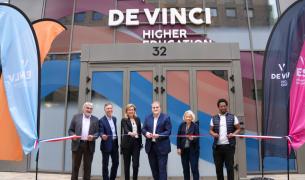
Dr Ranjan Chaudhuri is a Full Professor in the Department of Digital Marketing Business at EMLV Business School. Dr Ranjan Chaudhuri was a Fulbright Fellow at the University of Alabama in Huntsville in 2012. Dr Ranjan Chaudhuri in the recent past was a Professor of Marketing and Professor-in-charge (Institute Administration) at Indian Institute of Management Ranchi. In the recent past, he was associated with the National Institute of Industrial Engineering, Mumbai. Earlier, Dr. Chaudhuri also served as a Faculty at the Indian Institute of Technology Kharagpur and the Indian Institute of Technology Delhi. Dr. Chaudhuri has over twenty-two years of industrial, teaching, and research experience. Major awards and honors recently awarded to Dr. Chaudhuri include 2023 Basant Kumar BIrla Outstanding Management Researcher in India, InsideIIM Best Professor in Management for 2021, 2020 and 2019, for three times in a row, Bombay Management Association Outstanding Faculty of India Award 2020, Indian Institute of Technology Kharagpur Teaching Excellence Award 2018, All India Council for Robotics and Automation Lifetime Achievement Award 2019, Glory of India Award 2019, Academy of Management Professionals Best Teacher Award 2017, INFOMS USA Distinguished Service Award 2014, Fulbright Fellowship to United States, Fall 2012 (August - December 2012), Higher Education Forum (HEF) India Best Young Teacher Award 2012, Association of Indian Management Scholars (AIMS) International Outstanding Management Researcher Award 2010. He is also the recipient of the Jawaharlal Nehru Memorial Award, 2001 for best-published paper in the Journal of the Institution of Engineers (India), Interdisciplinary Division. Dr. Chaudhuri's teaching and research interests are in the areas of Business to Business Marketing, Global Marketing, and Retail Management.
Ranjan Chaudhuri; Bindu Singh; Amit Kumar Agrawal; Sheshadri Chatterjee; Shivam Gupta; Sachin Kumar Mangla
A TOE-DCV approach to green supply chain adoption for sustainable operations in the semiconductor industry Article de journal
Dans: International Journal Of Production Economics, vol. 275, p. 109327, 2024.
@article{chaudhuri_3096,
title = {A TOE-DCV approach to green supply chain adoption for sustainable operations in the semiconductor industry},
author = {Ranjan Chaudhuri and Bindu Singh and Amit Kumar Agrawal and Sheshadri Chatterjee and Shivam Gupta and Sachin Kumar Mangla},
url = {https://www.doi.org/10.1016/j.ijpe.2024.109327},
year = {2024},
date = {2024-09-01},
journal = {International Journal Of Production Economics},
volume = {275},
pages = {109327},
abstract = {Semiconductor industry plays a critical role for the global economy. Semiconductor industry provides various necessary technologies such as IoT, AI, modern fabrication technologies and so on to various industries including automotive industry, electronic and communication industry, healthcare industry, construction and building industry, space industry, and so on. However, semiconductor supply chain experiences various supply chain related risks and challenges because of its procedural complexities, global supply chain integrations, government policy and regulations, competitiveness, technological complexities, and so on. Not many studies available which investigated the risk, resilience, and complexities regarding green supply chain adoption by semiconductor industry. In this context, the objective of this study is to examine the risks, resilience, and complexities for managing the green supply chain adoption for higher sustainability in the semiconductor industry. Utilizing the TOE framework (Technology-Organization-Environment) and DCV (Dynamic Capability View), we developed a research model to achieve this purpose. Subsequently, this model was validated through structural equation modelling, involving 356 respondents affiliated with the semiconductor industry. This study highlights that technological risk aspects comprising of technological turbulence and risk, compatibility and complexity, organizational dynamic capabilities, and resilience along with appropriate policy and regulations could help successful adoption of green supply chain management in the semiconductor industry.},
keywords = {},
pubstate = {published},
tppubtype = {article}
}
Riad Shams; Sheshadri Chatterjee; Ranjan Chaudhuri
Developing brand identity and sales strategy in the digital era: Moderating role of consumer belief in brand Article de journal
Dans: Alliance Journal of Business Research, vol. 179, p. 114689, 2024.
@article{shams_3016,
title = {Developing brand identity and sales strategy in the digital era: Moderating role of consumer belief in brand},
author = {Riad Shams and Sheshadri Chatterjee and Ranjan Chaudhuri},
url = {https://www.sciencedirect.com/science/article/pii/S0148296324001930?via%3Dihub},
year = {2024},
date = {2024-06-01},
journal = {Alliance Journal of Business Research},
volume = {179},
pages = {114689},
abstract = {Brand identity helps customers to identify, as well as distinguish alternative competitive brands. If there is a consistent marketing strategy and consistent messaging, brand identity remains consistent, which helps in improving sales management and generating better revenue for the brand. In this digital era, there are various digital marketing tools and capabilities to improve brand identity, which help in establishing close association with customers to influence their purchasing decisions. However, we have limited understanding of the antecedents of brand identity in the digital era, and how the moderating role of consumer belief in brands could influence their purchasing decision making process. In this context, this study aims to determine the antecedents of brand identity in the digital era, and to examine if there is any moderating impact of consumer belief in brand (CBB) on consumer purchase decision (CPD). Based on the resource-based view and social identity theory, a theoretical model has been developed. Following the survey responses of representatives from 302 organizations/brands, the covariance-based structural equation modelling validates our model. Our analysis affirms that e-WOM, digital infrastructure, skilled manpower, and digital marketing capability positively impact on developing brand identity, which influences sales strategy differently in different situation to influence CPD, where CBB plays a moderating role. The study results have been derived by analyzing the inputs of the respondents based out of India which invited external validity issue and it has been considered as one of the limitations of this study.},
keywords = {},
pubstate = {published},
tppubtype = {article}
}
Bindu Singh; Shefali Srivastava; Ranjan Chaudhuri; Sheshadri Chatterjee; Demetris Vrontis
Assessing the entrepreneurial business performance from a dynamic capability and TOE framework: moderating role of crowdfunding support Article de journal
Dans: Journal of Small Business and Enterprise Development, 2024.
@article{singh_3052,
title = {Assessing the entrepreneurial business performance from a dynamic capability and TOE framework: moderating role of crowdfunding support},
author = {Bindu Singh and Shefali Srivastava and Ranjan Chaudhuri and Sheshadri Chatterjee and Demetris Vrontis},
url = {https://www.doi.org/10.1108/JSBED-10-2023-0462},
year = {2024},
date = {2024-06-01},
journal = {Journal of Small Business and Enterprise Development},
abstract = {Purpose - This study aims at assessing entrepreneurial business performance (EBP) from dynamic capability
(DC) and technology-organization-environment (TOE) framework perspectives, taking support from
crowdfunding.
Design/methodology/approach - With the inputs from the literature, supported by TOE framework and
the dynamic capability view (DCV), a model has been proposed. This model has been tested by the factor-based
partial least squares structural equation modeling (PLS-SEM) technique through a survey and quantifying the
responses of 406 respondents on a five-point Likert scale has been used.
Findings - The study has found that crowdfunding support (CFS) has an effective influence on the
improvement of EBP. Also, the DC supports to improve the EBP. Environmental dynamism (END) has also a
critical role in impacting business performance.
Research limitations/implications - Crowdfunding involves investors who have a similar interest in the
business, close friends, family members, venture capitalists, investment groups, etc. Thus, the proposed model
can be used by these stakeholders for investment purposes as well as for improving EBP. This study is a cross
sectional research work which has limitations. Moreover, the sample size of this project is limited and did not
include global respondents, Thus, the findings of this study cannot be generalizable which is another limitation
of this study.
Practical implications - Crowdfunding involves investors who have a similar interest in the business, such
as close friends, family members, venture capitalists, investment groups, etc. Thus, the proposed model can be
used by these stakeholders for investment purposes as well as for improving EBP. The study can help
policymakers understand the importance of crowdfunding in promoting entrepreneurship activities in a
region, which helps in the economic development of that region.
Originality/value - This research work enriches the extant literature in the fields of crowdfunding and
investment, DC and entrepreneurship. Not many studies have dealt with the issues of CFS for the improvement
of EBP. Hence, this study may be considered novel. Moreover, the proposed research framework related to
crowdfunding possesses a high predictive power. This makes the study unique.},
keywords = {},
pubstate = {online},
tppubtype = {article}
}
Swati Chaudhary; Aditi Gupta; Apoorva A.; Ranjan Chaudhuri; Vijay Pereira; Sheshadri Chatterjee; Sumana Chaudhuri
A study of ?organizational identification? during 1965-2022: a bibliometric analysis Article de journal
Dans: International Journal of Organizational Analysis, 2024.
@article{chaudhary_2935,
title = {A study of ?organizational identification? during 1965-2022: a bibliometric analysis},
author = {Swati Chaudhary and Aditi Gupta and Apoorva A. and Ranjan Chaudhuri and Vijay Pereira and Sheshadri Chatterjee and Sumana Chaudhuri},
url = {https://www.emerald.com/insight/content/doi/10.1108/IJOA-10-2023-4025/full/html},
year = {2024},
date = {2024-05-01},
journal = {International Journal of Organizational Analysis},
abstract = {Purpose
This paper aims to examine the evolution of organizational identification (OI) research over the past five decades and its journey through various lenses, such as the collaborative network of authors, organizations and countries. The conceptual and intellectual structure of the construct is analysed via keywords and co-citation pattern mapping.
Design/methodology/approach
OI research is rising in popularity, with 118 papers published in 2019, 168 papers in 2020 and 15 publications till February 2021 in the Scopus database. The Scopus database is used to retrieve 55?years of OI studies published between 1965 and 2021. The free bibliometric tools Biblioshiny and VOSviewer are used to analyse 1,034 journal papers.
Findings
The result showed that R. Van Dick is the most influential author and the USA is the most involved country in OI research. As per the findings, the Journal of Organizational Behaviour published most of OI research and ?corporate social responsibility? and ?organizational commitment? seem to be the most used keywords alongside OI.
Research limitations/implications
This study will be highly beneficial to OI researchers making their understanding about the construct better. It will also encourage social psychologists to understand the construct utility in workplace social welfare programmes. The research could also help governments and funding bodies to evaluate grant requests. Furthermore, researchers from countries with the lowest proportion of OI studies would be encouraged to spend more time and effort in this area. It will offer insight into international marketing and how individuals and stakeholders perceive and connect with an organization globally.
Originality/value
To the best of the authors' knowledge, this study is one of the important research studies carried out in the domain of OI in the international context. This is also one of the few studies which is spread out across different disciplinary areas including international marketing and management. The success of this paper can open avenues and influence future researchers to study in the OI and related cross-disciplinary areas of international management.},
keywords = {},
pubstate = {online},
tppubtype = {article}
}
Evangelia Siachou; Ranjan Chaudhuri; Sheshadri Chatterjee; Demetris Vrontis; Minas Kastanakis; Markella Barouta
Is humility in leadership a promoter of employee voice? A moderated mediation model Article de journal
Dans: European Management Journal, 2024.
@article{siachou_2925,
title = {Is humility in leadership a promoter of employee voice? A moderated mediation model},
author = {Evangelia Siachou and Ranjan Chaudhuri and Sheshadri Chatterjee and Demetris Vrontis and Minas Kastanakis and Markella Barouta},
url = {https://www.sciencedirect.com/science/article/abs/pii/S0263237324000148},
year = {2024},
date = {2024-04-01},
journal = {European Management Journal},
abstract = {Purpose: In this study, we provide a better understanding of the role of leader humility in employee voice by
examining simultaneously the mediating role of intention to share knowledge and the moderating role of
organizational tenure.
Design/methodology: We developed and tested a mediated moderation model. The study hypotheses were tested
with partial least squares structural equation modeling techniques.
Findings: Results from 309 medical representatives supported the study hypotheses, indicating that leader humility
is related to employee voice via intention to share knowledge, and this relationship is stronger for shortertenured
employees than for longer-tenured ones. The study also provides implications for both theory and
practice.
Practical implications: The study provides empirical evidence in support of the positive effect of leader humility on
employee voice. Therefore, we suggest that executive administration should pay particular attention to promoting
humility in leadership to appropriately manage extra-role behavior such as employee voice.
Originality: Recently, leader humility has attracted scholarly attention in organization studies. It is considered a
key antecedent of employees' extra-role behavior and a contextual factor that is associated with many positive
employee and organizational outcomes.},
keywords = {},
pubstate = {online},
tppubtype = {article}
}
Ranjan Chaudhuri; Sheshadri Chatterjee; Sachin Kamble; Shivam Gupta; Nelson Oly Ndubisi; Amine Belhadi
Corporate entrepreneurial leadership, resources, capabilities, and sustainable performance Article de journal
Dans: Business Strategy And The Environment, vol. 33, no. 3, p. 2066-2083, 2024.
@article{chaudhuri_2909,
title = {Corporate entrepreneurial leadership, resources, capabilities, and sustainable performance},
author = {Ranjan Chaudhuri and Sheshadri Chatterjee and Sachin Kamble and Shivam Gupta and Nelson Oly Ndubisi and Amine Belhadi},
url = {https://onlinelibrary.wiley.com/doi/10.1002/bse.3585},
year = {2024},
date = {2024-03-01},
journal = {Business Strategy And The Environment},
volume = {33},
number = {3},
pages = {2066-2083},
abstract = {Corporate entrepreneurial leadership (CEL) plays a critical role in promoting innovative behavior that disrupts existing practices in organizations, to say the least, encouraging new policy initiatives that could affect the business and social performance of the organizations under their sustainable development goals (SDGs). CEL can help achieve SDGs by redesigning different contextual factors to help promote various policy initiatives. In this vein, this study identifies the factors which could improve the business and social performance of the organizations helping to achieve SDGs through an amalgam of theoretical lenses, particularly the dynamic capability view. Based on extant literature, we developed, validated, and applied a theoretical model using the partial least square structural equation modeling technique on data collected from 327 respondents from different organizations. The study found that CEL capability significantly and positively impacts the various organizational entities and resources, which in turn affects the business and social performance of the organizations. Theoretical and managerial implications of the findings are also discussed.},
keywords = {},
pubstate = {published},
tppubtype = {article}
}
Ranjan Chaudhuri; Sheshadri Chatterjee; Marcello Mariani; Samuel Fosso Wamba
Assessing the influence of emerging technologies on organizational data driven culture and innovation capabilities: A sustainability performance perspective Article de journal
Dans: Technological Forecasting And Social Change, vol. 200, p. 123165, 2024.
@article{chaudhuri_2924,
title = {Assessing the influence of emerging technologies on organizational data driven culture and innovation capabilities: A sustainability performance perspective},
author = {Ranjan Chaudhuri and Sheshadri Chatterjee and Marcello Mariani and Samuel Fosso Wamba},
url = {https://www.sciencedirect.com/science/article/pii/S0040162523008508?via%3Dihub},
year = {2024},
date = {2024-03-01},
journal = {Technological Forecasting And Social Change},
volume = {200},
pages = {123165},
abstract = {Industry 4.0 applications can accelerate data driven decision making culture in organizations. Such data driven
culture can have a profound impact on the organizational capabilities underlying product and process innovation. While there is a relatively developed body of literature on the effect of data driven culture on organizational
performance, there is virtually no study that has examined how Industry 4.0 influences the data driven culture of
organizations and how in its turn such culture influences both product and process innovation. Furthermore, the
role of organizational data driven culture has seldom been examined in relation to organizational sustainability
performance. Against this backdrop, the aim of this study is to examine the role of emerging Industry 4.0
technologies on the data driven culture of organizations and analyze if and how such data driven culture influences organizational performance ultimately translating into competitive advantage. By leveraging the
Resource Based View (RBV) and Dynamic Capabilities theory, we developed a theoretical model and tested it
using a PLS-SEM approach on a sample of 416 organizations. We found that adoption of industry 4.0 technologies
influences organizational performance by improving social, competitive, and financial performance of the organizations relying on data driven culture and improved innovative capabilitie},
keywords = {},
pubstate = {published},
tppubtype = {article}
}
Sheshadri Chatterjee; Ranjan Chaudhuri; Demetris Vrontis; Léo-Paul Dana; Diala Kabbara
Developing resilience of MNEs: From global value chain (GVC) capability and performance perspectives Article de journal
Dans: Journal Of Business Research, vol. 172, p. 114447, 2024.
@article{chatterjee_2915,
title = {Developing resilience of MNEs: From global value chain (GVC) capability and performance perspectives},
author = {Sheshadri Chatterjee and Ranjan Chaudhuri and Demetris Vrontis and Léo-Paul Dana and Diala Kabbara},
url = {https://www.sciencedirect.com/science/article/pii/S0148296323008068?via%3Dihub},
year = {2024},
date = {2024-02-01},
journal = {Journal Of Business Research},
volume = {172},
pages = {114447},
note = {External shocks create various risks for enterprises. Multinational enterprises (MNEs) work to develop resilience and improve their global risk management capability. The COVID-19 pandemic has compelled MNEs to improve their global value chain (GVC) capability to enhance their global risk management and operational performance, which could eventually impact their overall performance. Developing GVC capability is a challenge for MNEs. This study aims to examine the influence of global risk management capability on MNEs' GVC capability to become more resilient to withstand such crises and further enhance their performance. Building on the resource-based view (RBV), dynamic capability view (DCV), and the existing literature, a conceptual research model was prepared. The model was then validated using the PLS-SEM technique to analyze the responses of the 323 managers at different MNEs. The study found a significant positive impact of global risk management capability on GVC capability, which eventually impacted MNE performance.},
keywords = {},
pubstate = {published},
tppubtype = {article}
}
Ranjan Chaudhuri; Demetris Vrontis; Sheshadri Chatterjee
External environment and internal dynamics of ?born global?: strategic and operational firm performance Article de journal
Dans: Management Decision, vol. 62, no. 1, p. 274-300, 2024.
@article{chaudhuri_2919,
title = {External environment and internal dynamics of ?born global?: strategic and operational firm performance},
author = {Ranjan Chaudhuri and Demetris Vrontis and Sheshadri Chatterjee},
url = {https://www.emerald.com/insight/content/doi/10.1108/MD-02-2023-0168/full/html},
year = {2024},
date = {2024-01-01},
journal = {Management Decision},
volume = {62},
number = {1},
pages = {274-300},
abstract = {Purpose
?Born global firms? are those organizations which, from their inception and by nature, adopt an essentially global-scale entrepreneurial functional and attitudinal strategy for growth. They seek to gain significant competitive advantage by utilizing their internal resources while leveraging external environment potentialities, to sell their outputs internationally. The aim of this research is to investigate the influence of the external business environment and the dynamic capabilities of born global firms, on their strategic and operational performance, as well as the role of leadership vision on their internationalization performance.
Design/methodology/approach
Initially and resting on extant literature with pertinent foci, including the absorptive capacity and the dynamic capability view theories, a conceptual model is proposed. Subsequently, the model is validated through the partial least square structural equation modeling technique, based on 417 respondents from Indian firms.
Findings
The study concludes that the external business environment and internal dynamic capabilities of born global firms have a significant and positive impact on their strategic, as well as operational performance; with leadership vision playing a significant moderating role to this relationship. The study finally presents the executive implications of the findings and identifies the avenues for further scientific research.
Originality/value
This is a unique study on the topic, both in relation to resources/capabilities versus performance and with regards to the leadership vision's role. It moreover focuses on a primary business force, India, which comprises prime examples of global entrepreneurship. The research constituting a significant contribution to knowledge, as research on how small firms can strategically grow so rapidly and effectively, is still far from conclusive, particularly under the present evolutions that incessantly redefine the contextual business forces upon which strategy is drawn.},
keywords = {},
pubstate = {published},
tppubtype = {article}
}
Sheshadri Chatterjee; Ranjan Chaudhuri
Impacts of Industry 5.0 in Supply Chain Flow in Post COVID-19 Era: Moderating Role of Senior Leadership Support Article de journal
Dans: Information Systems Frontiers, 2024.
@article{chatterjee_2920,
title = {Impacts of Industry 5.0 in Supply Chain Flow in Post COVID-19 Era: Moderating Role of Senior Leadership Support},
author = {Sheshadri Chatterjee and Ranjan Chaudhuri},
url = {https://link.springer.com/article/10.1007/s10796-023-10463-w},
year = {2024},
date = {2024-01-01},
journal = {Information Systems Frontiers},
abstract = {Industry 5.0 involves human and machines reunion by working together to improve the efficiency of service and production process. Industry 5.0 helps to create platforms for better value cocreation and open business models. Such open business model supports in integrating organizational competencies and customers' preferences along with ensuring better services to meet the challenging needs of the tomorrows' business world. It is an upcoming field of research and not many studies are available to understand the consequences of Industry 5.0 in the context of ambidexterity and absorptive capacity of the organization, especially from supply chain flow perspective in post COVID-19 period. Also, not many studies are available which have investigated the role of senior leadership support to facilitate adoption of industry 5.0 and sustainability of supply chain management process in the post COVID-19 period. With the support of absorptive capacity theory and existing literature, a conceptual model has been developed which was later validated using PLS-SEM technique considering 378 respondents from different industries. The study found that there is a significant impact of absorptive capacity of the organization towards successfully using industry 5.0 related technologies which in turn positively and significantly influence sustenance of supply chain flow in post COVID-19 period. The study also found that senior leadership support is necessary to successfully adopt and use industry 5.0 for sustaining supply chain flow in the post COVID-19 period.},
keywords = {},
pubstate = {online},
tppubtype = {article}
}
Ranjan Chaudhuri; Sheshadri Chatterjee; Shivam Gupta; Sachin Kamble
Green supply chain technology and organization performance: Moderating role of environmental dynamism and product-service innovation capability Article de journal
Dans: Technovation, vol. 128, p. 102857, 2023.
@article{chaudhuri_2908,
title = {Green supply chain technology and organization performance: Moderating role of environmental dynamism and product-service innovation capability},
author = {Ranjan Chaudhuri and Sheshadri Chatterjee and Shivam Gupta and Sachin Kamble},
url = {https://doi.org/10.1016/j.technovation.2023.102857},
year = {2023},
date = {2023-12-01},
journal = {Technovation},
volume = {128},
pages = {102857},
abstract = {The green supply chain management (GSCM) system is considered as an environmentally friendly approach
which considers different environmental issues in supply chain flow. There are different underlying technologies
used in implementing GSCM; yet, we still have limited knowledge concerning how green SCM technology can
enhance organizational performance. Further, the conditions that indirectly affect organizational performance
within this context remain underexplored. Drawing on this gap of knowledge, the purpose of this research work
is to investigate how adoption of GSCM can improve organizational performance. We also argue that the
dynamism of the environment and the product-service innovation capability of organizations will have conditioning effects on this relationship. Grounded on the dynamic capability view as a theoretical lens, a conceptual
model has been developed which is explored through feedback from 307 organizations involved in green supply
chain management activities. We find that environmental dynamism and product-service innovation capability
have moderating impacts on adopting green supply chain technology and organizational performance. The
outcomes also indicate that green supply chain technology can considerably improve business value under
certain contextual factors.},
keywords = {},
pubstate = {published},
tppubtype = {article}
}
Sheshadri Chatterjee; Ranjan Chaudhuri; Marcello Mariani; Samuel Fosso Wamba
The consequences of innovation failure: An innovation capabilities and dynamic capabilities perspective Article de journal
Dans: Technovation, vol. 128, p. 102858, 2023.
@article{chatterjee_2914,
title = {The consequences of innovation failure: An innovation capabilities and dynamic capabilities perspective},
author = {Sheshadri Chatterjee and Ranjan Chaudhuri and Marcello Mariani and Samuel Fosso Wamba},
url = {https://www.sciencedirect.com/science/article/pii/S0166497223001694?via%3Dihub},
year = {2023},
date = {2023-12-01},
journal = {Technovation},
volume = {128},
pages = {102858},
abstract = {Organizations engage with innovation by leveraging their innovation capabilities and dynamic capabilities. In this study, we examined how organizational innovation capabilities and dynamic capabilities can influence organizational performance, taking into account cases when innovation projects do not yield beneficial outcomes to organizations. Building on the dynamic capability view and the notion of innovation capability, we developed a conceptual model and subsequently validated it by conducting a survey on a sample of organizations across multiple manufacturing and service industries that are based in India. By applying PLS-SEM, we found that different contextual factors including commercial viability and technological feasibility play a critical role towards innovation failure and success. In its turn, innovation failure negatively influences organizational performance.},
keywords = {},
pubstate = {published},
tppubtype = {article}
}
Sheshadri Chatterjee; Ranjan Chaudhuri; Marcello Mariani; Samuel Fosso Wamba
Examining the role of intellectual capital on knowledge sharing in digital platform-based MNEs and its impact on firm performance Article de journal
Dans: Technological Forecasting And Social Change, vol. 197, p. 122909, 2023.
@article{chatterjee_2916,
title = {Examining the role of intellectual capital on knowledge sharing in digital platform-based MNEs and its impact on firm performance},
author = {Sheshadri Chatterjee and Ranjan Chaudhuri and Marcello Mariani and Samuel Fosso Wamba},
url = {https://www.sciencedirect.com/science/article/pii/S0040162523005942?via%3Dihub},
year = {2023},
date = {2023-12-01},
journal = {Technological Forecasting And Social Change},
volume = {197},
pages = {122909},
abstract = {Non-market strategies are strategies that happen outside the marketplace. Despite their increasing relevance, they have been overlooked when studying digital platform-based enterprises. To address this gap, our study focuses on digital platforms and builds and tests hypotheses in relation to digital platform based MNEs. First, we identify several antecedents and consequences of the adoption of non-market strategies by digital platform-based multinational enterprises (MNEs). Secondly, after conducting a survey on 11 digital platform-based MNEs, we deploy the PLS-SEM technique to analyze the data. We find that intellectual capital positively influences digital platform-based MNE subsidiaries' knowledge sharing and seeking. This, in turn, positively influences coordination and cooperation that ultimately positively affect firm performance. This study makes several contributions. First, it suggests that the evolution of digital platform-based MNEs involves also non-market strategies. Second, it finds that intellectual capital is among the most relevant antecedents of the adoption of non-market strategies by digital platform-based MNEs. Third, it reveals that the adoption of non-market strategies by MNE subsidiaries is conducive to highest levels of firm performance for digital platform-based MNEs themselves. Last, it finds that coordination and cooperation represent enablers of the relationship between knowledge transfer and firm performance.},
keywords = {},
pubstate = {published},
tppubtype = {article}
}
Sheshadri Chatterjee; Ranjan Chaudhuri; Shivam Gupta; Uthayasankar Sivarajah; Surajit Bag
Assessing the impact of big data analytics on decision-making processes, forecasting, and performance of a firm Article de journal
Dans: Technological Forecasting And Social Change, vol. 196, p. 122824, 2023.
@article{chatterjee_2420,
title = {Assessing the impact of big data analytics on decision-making processes, forecasting, and performance of a firm},
author = {Sheshadri Chatterjee and Ranjan Chaudhuri and Shivam Gupta and Uthayasankar Sivarajah and Surajit Bag},
url = {https://www.sciencedirect.com/science/article/pii/S0040162523005097},
year = {2023},
date = {2023-11-01},
journal = {Technological Forecasting And Social Change},
volume = {196},
pages = {122824},
abstract = {There are various kinds of applications of BDA in the firms. Not many studies are there which deal with the impact of BDA towards issues like forecasting, decision-making, as well as performance of the firms simultaneously. So, there exists a gap in the research. In such a background, this study aims at examining the impacts of BDA on the process of decision-making, forecasting, as well as firm performance. Using resource-based view (RBV) as well as dynamic capability view (DCV) and related research studies, a research model was proposed conceptually. This conceptual model was validated taking help of PLS-SEM approach considering 366 respondents from Indian firms. This study has highlighted that smart decision making and accurate forecasting process can be achieved by using BDA. This research has demonstrated that there is a considerable influence of adoption of BDA on decision making process, forecasting process, as well as overall firm performance. However, the present study suffers from the fact that the study results depend on the cross-sectional data which could invite defects of causality and endogeneity bias. The present research work also found that there is no impact of different control variables on the firm's performance.},
keywords = {},
pubstate = {published},
tppubtype = {article}
}
Sheshadri Chatterjee; Ranjan Chaudhuri; Ajay Kumar; Francesco Schiavone
Emergence of Social Robot Technology and Its Friction-Free Diffusion in Society: From Engineering Aesthetics and Compatibility Perspective Article de journal
Dans: Ieee Transactions On Engineering Management, 2023.
@article{chatterjee_2910,
title = {Emergence of Social Robot Technology and Its Friction-Free Diffusion in Society: From Engineering Aesthetics and Compatibility Perspective},
author = {Sheshadri Chatterjee and Ranjan Chaudhuri and Ajay Kumar and Francesco Schiavone},
url = {https://ieeexplore.ieee.org/document/10309836},
year = {2023},
date = {2023-11-01},
journal = {Ieee Transactions On Engineering Management},
abstract = {A social robot utilizes artificial intelligence (AI) technology to engage and interact with humans and several studies have explored the various functionalities of social robots. However, limited research has been conducted on how factors such as aesthetics and compatibility can influence individuals' intention to use social robots. Consequently, the aim of this research study is to address this gap and provide insights in this area. The study adopts the technology acceptance model, theory of planned behavior, and innovation diffusion theory to investigate the cognitive and psychological factors that impact an individual's intention to use social robots. The study uses self-efficacy, and innovativeness as the predictors of compatibility. Also, the study uses personal norms, and social norms as predictors of aesthetics. Taking account of theories and current literature, we developed a conceptual model and validated it using the partial least squares structural equation modeling technique with 372 respondents. The study found that compatibility and aesthetics are important factors impacting individuals' intentions to use social robots.},
keywords = {},
pubstate = {online},
tppubtype = {article}
}
Sheshadri Chatterjee; Ranjan Chaudhuri; Alberto Ferraris; Georgia Sakka; Sumana Chaudhuri
Implications of dynamic capabilities on triple bottom line performance after the COVID-19 pandemic: An empirical insight from B2B marketing perspective Article de journal
Dans: Industrial Marketing Management, vol. 115, p. 240-252, 2023.
@article{chatterjee_2912,
title = {Implications of dynamic capabilities on triple bottom line performance after the COVID-19 pandemic: An empirical insight from B2B marketing perspective},
author = {Sheshadri Chatterjee and Ranjan Chaudhuri and Alberto Ferraris and Georgia Sakka and Sumana Chaudhuri},
url = {https://www.sciencedirect.com/science/article/pii/S0019850123001955?via%3Dihub},
year = {2023},
date = {2023-11-01},
journal = {Industrial Marketing Management},
volume = {115},
pages = {240-252},
abstract = {Triple bottom line (TBL) is a concept of business which highlights that firms should not measure their business success based only on their financial performance, but they should also measure their social and environmental impacts. In other words, the concept of triple bottom line also includes people, planet, and profit. Also, dynamic capabilities help a firm to address rapid environmental changes, and studies have shown that they can improve a firm's sustainability performance. Other studies have shown that TBL initiatives can also improve a firm's sustainability performance. But no studies have investigated how dynamic abilities as well as TBL initiatives could simultaneously impact sustainability performance of B2B firms in the post COVID-19 period. Therefore, the aim of this study is to examine the implications of dynamic capabilities on TBL performance after the COVID-19 pandemic, especially from the B2B marketing perspective. Drawing on dynamic capability view (DCV), TBL theory and the extant literature, a conceptual research model was developed which was subsequently validated with the PLS-SEM technique using 377 responses from different manufacturing and service-oriented firms. This is the first study to extensively analyze the combined impacts of these two dimensions on firms' sustainability performance, and thus it has enriched the literature related to DCV, TBL, and sustainability.},
keywords = {},
pubstate = {published},
tppubtype = {article}
}
Sheshadri Chatterjee; Ranjan Chaudhuri; Demetris Vrontis
Acceptance of social robot and its challenges: From privacy calculus perspectives Article de journal
Dans: Technological Forecasting And Social Change, vol. 196, p. 122862, 2023.
@article{chatterjee_2913,
title = {Acceptance of social robot and its challenges: From privacy calculus perspectives},
author = {Sheshadri Chatterjee and Ranjan Chaudhuri and Demetris Vrontis},
url = {https://www.sciencedirect.com/science/article/pii/S0040162523005474?via%3Dihub},
year = {2023},
date = {2023-11-01},
journal = {Technological Forecasting And Social Change},
volume = {196},
pages = {122862},
abstract = {The aim of this study is to examine human-robot interaction (HRI) from the perspective of security, privacy, as well as social and personal norms. This study also strives to investigate users' hedonic and utilitarian attitudes towards using social robots. A social robot is a physical humanoid robot that communicates and interacts with humans and other devices. Social robots follow social rules and behaviors which make them different from other kinds of robots. They often behave like social partners to humans and have features such as eye-gaze, speech recognition, auto-gestures, and so on. Social robots use different types of sensitive data from the users which could pose security challenges and privacy threats. Not many studies have dealt with human-robot interactions (HRI) from security, privacy, social norms, and personal norms perspectives. With the existing literature as well as privacy calculus, motivational theory, and theory of planned behavior (TPB), a model has been developed conceptually, which was then validated using a sample of 403 users contemplating using social robots in the coming days. The study found that both users' hedonic and utilitarian attitudes impact significantly and positively their usage of social robots.
Previous article in issueNext article in issue
Keywords
HRISocial robots' acceptanceHedonic and utilitarian attitudePrivacy calculusSocial and personal norm},
keywords = {},
pubstate = {published},
tppubtype = {article}
}
Sheshadri Chatterjee; Ranjan Chaudhuri; Shivam Gupta; Sachin Kamble
Examining the influence of industry 4.0 in healthcare supply chain performance: Moderating role of environmental dynamism Article de journal
Dans: Journal Of Cleaner Production, vol. 427, p. 139195, 2023.
@article{chatterjee_2918,
title = {Examining the influence of industry 4.0 in healthcare supply chain performance: Moderating role of environmental dynamism},
author = {Sheshadri Chatterjee and Ranjan Chaudhuri and Shivam Gupta and Sachin Kamble},
url = {https://www.sciencedirect.com/science/article/pii/S095965262303353X?via%3Dihub},
year = {2023},
date = {2023-11-01},
journal = {Journal Of Cleaner Production},
volume = {427},
pages = {139195},
abstract = {Healthcare supply chain management (HCSCM) is a network of different systems, tools, and processes. This system works in a seamless manner to ensure healthcare related materials such as medicines, hospital supplies, and so on. These materials are manufactured in the firms, distributed through agents, and eventually reach patients on time. During COVID-19, HCSCM was severely impacted in many countries. Many patients had to face severe difficulties during the pandemic. But post pandemic and after the adoption of several modern technologies like Industry 4.0, the performance of HCSCM was more reliable. Not many studies are available which have examined the influence of Industry 4.0 in HCSCM during such a crisis. In such context, the study aims at examining the influence of Industry 4.0 in HCSCM with moderating role of environmental dynamism. A conceptual model is proposed with the support of theories and literature. This was later validated by PLS-SEM approach considering 312 respondents from people of HCSCM system. The study ascertained that Industry 4.0 has greatly improved the performance of HCSCM system after COVID-19 crisis. In addition, this study highlighted that environmental dynamism has a significant moderating role on the linkage between adoption of industry 4.0 technology with HCSCM.},
keywords = {},
pubstate = {published},
tppubtype = {article}
}
Sheshadri Chatterjee; Ranjan Chaudhuri; Ajay Kumar; Shivam Gupta; Pooja Sengupta
Rethinking of firm innovation capability: Examining the moderating role of leadership ability on a new business model Article de journal
Dans: Technological Forecasting And Social Change, vol. 195, p. 122771, 2023.
@article{chatterjee_2829,
title = {Rethinking of firm innovation capability: Examining the moderating role of leadership ability on a new business model},
author = {Sheshadri Chatterjee and Ranjan Chaudhuri and Ajay Kumar and Shivam Gupta and Pooja Sengupta},
url = {https://doi.org/10.1016/j.techfore.2023.122771},
year = {2023},
date = {2023-10-01},
journal = {Technological Forecasting And Social Change},
volume = {195},
pages = {122771},
abstract = {?Market-driving' is a concept for changing the composition, behavior, and/or roles of different players in a specific market. Market-driving firms shape the future course of a market and could influence the other firms in the market, customer preferences, and business relationships and even redesign the value proposition for a certain segment of customers. Leadership ability helps to achieve better firm performance through market-driving competency. Although there are a few studies in these areas, there are only limited studies that investigate the role of leadership ability and market-driving competency in influencing the marketing and financial performance of a firm. Under such circumstances, the aim of this study is to rethink the firm innovation capability and propose a new business model from the B2B Market-driving competency and leadership ability perspectives. The proposed business model is derived from the theories of the resource-based view (RBV) and dynamic capability view (DCV). CB-SEM technique is used to test the model with 412 responses from B2B firms. The new business model is supported by the firm's internal capabilities and leadership style. The study also finds branding, relationship marketing, and innovation capabilities as antecedents of market-driving competency with leadership style being an important moderator to improving market-driving competency and firm performance.},
keywords = {},
pubstate = {published},
tppubtype = {article}
}
Sheshadri Chatterjee; Ranjan Chaudhuri; Demetris Vrontis; Raj Mahto
Bright and dark sides of adopting a platform-based sharing economy business model Article de journal
Dans: R&D Management, 2023.
@article{chatterjee_2917,
title = {Bright and dark sides of adopting a platform-based sharing economy business model},
author = {Sheshadri Chatterjee and Ranjan Chaudhuri and Demetris Vrontis and Raj Mahto},
url = {https://onlinelibrary.wiley.com/doi/epdf/10.1111/radm.12650},
year = {2023},
date = {2023-10-01},
journal = {R&D Management},
abstract = {The sharing economy is primarily a socio-economic concept that is built upon organizations sharing resources between each other. It includes sharing a single platform by multiple organizations. These organizations can be rivals competing in the same marketplace. Often, organizations can share their employees, data, and other resources. Although there are multiple benefits in a platform-based sharing economy business model, there are some ethical concerns, too. Limited studies have extensively investigated how adopting a platform-based sharing economy business model could provide both opportunities and challenges impacting the intention of the organizations to adopt this model. From such a perspective, this study aims at an in-depth investigation of employees' perceptions regarding the intention of adopting sharing economy models through which organizations could enjoy various benefits that overcome the risks. With the help of a resource-based view with other theories and the extant literature, a conceptual model has been developed, which later has been validated using the PLS-SEM technique considering 376 responses from different organizations in India. This study has demonstrated how the benefits derived from adopting a platform-based sharing economy business model overcome the risks involved and could motivate organizations to intend to adopt such a business model.},
keywords = {},
pubstate = {online},
tppubtype = {article}
}
Ranjan Chaudhuri; Demetris Vrontis; Sheshadri Chatterjee
Reimaging Emerging Technologies for Digital Transformation and Growth Trajectory of Organizations in New Normal: The Moderating Role of Organizational Data-Driven Culture Article de journal
Dans: Ieee Transactions On Engineering Management, 2023.
@article{chaudhuri_2911,
title = {Reimaging Emerging Technologies for Digital Transformation and Growth Trajectory of Organizations in New Normal: The Moderating Role of Organizational Data-Driven Culture},
author = {Ranjan Chaudhuri and Demetris Vrontis and Sheshadri Chatterjee},
url = {https://ieeexplore.ieee.org/document/10256670},
year = {2023},
date = {2023-09-01},
journal = {Ieee Transactions On Engineering Management},
abstract = {Emerging technologies, such as artificial intelligence, big data analytics, and blockchain, play a major role in the digitalization of organizations. Data are important for decision-making processes. Organizations need to establish a data-driven culture to support the digital transformation process. However, extant literature is scant to investigate the effects of digitalization on organizational sustainability performance. In this context, this study aims to investigate how data-driven culture and digital transformation could impact organizational sustainability performance by improving some intermediate contextual factors. To investigate the effects of digitalization, this study has developed a theoretical model with the knowledge of literature and theories. Later, the model has been statistically validated. This study claims its uniqueness because no other studies have extensively demonstrated that applications of digital technologies in a data-driven culture could improve the sustainability performance of organizations by improving product and process innovation and the financial and operational performance of organizations. However, the study results suffer from external validity issues, as the analysis of the results depends on the inputs of the respondents who are based out of India. This has been considered as a limitation in this study.},
keywords = {},
pubstate = {online},
tppubtype = {article}
}
Ranjan Chaudhuri
Triple Bottom Line Performance in Post Covid B2B Marketing Divers
FNEGE Médias, 2024.
@misc{chaudhuri_2962,
title = {Triple Bottom Line Performance in Post Covid B2B Marketing},
author = {Ranjan Chaudhuri},
url = {https://fnege-medias.fr/fnege-video/triple-bottom-line-performance-in-post-covid-b2b-marketing/},
year = {2024},
date = {2024-04-01},
howpublished = {FNEGE Médias},
note = {The Triple Bottom Line (TBL) concept emphasizes that business success should not be measured solely by financial performance. It includes social and environmental impacts alongside profit. Additionally, dynamic capabilities help firms adapt to rapid environmental changes and enhance sustainability performance. Previous studies have shown that TBL initiatives can also improve sustainability performance. However, no research has investigated how dynamic abilities and TBL initiatives jointly impact B2B firms' sustainability performance in the post-COVID-19 period. This study aims to examine the implications of dynamic capabilities on TBL performance, particularly from a B2B marketing perspective. By developing and validating a conceptual research model, it contributes to the literature related to dynamic capability view, TBL, and sustainability.},
keywords = {},
pubstate = {published},
tppubtype = {misc}
}
Ranjan Chaudhuri
Triple Bottom Line Performance in Post Covid B2B Marketing Divers
FNEGE Médias, 2024.
@misc{chaudhuri_3007,
title = {Triple Bottom Line Performance in Post Covid B2B Marketing},
author = {Ranjan Chaudhuri},
url = {https://fnege-medias.fr/podcast/triple-bottom-line-performance-in-post-covid-b2b-marketing/},
year = {2024},
date = {2024-04-01},
howpublished = {FNEGE Médias},
note = {podcast},
keywords = {},
pubstate = {published},
tppubtype = {misc}
}
No posts by this author.
N'hésitez pas à contacter le service des admissions pour tout renseignement complémentaire :










